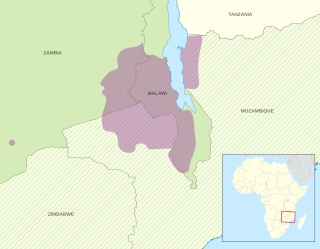| Chewa | |
|---|---|
| Nyanja | |
| Chichewa, Chinyanja | |
| Native to | Malawi |
| Region | Southeast Africa |
| Ethnicity | Chewa |
Native speakers | 7 million (2007)[1] |
| Latin (Chewa alphabet) Mwangwego Chewa Braille | |
| Official status | |
Official language in | |
| Language codes | |
| ISO 639-1 | ny |
| ISO 639-2 | nya |
| ISO 639-3 | nya |
| Glottolog | nyan1308 |
N.30 (N.31, N.121)[3] | |
| Linguasphere | 99-AUS-xaa – xag |
 Areas where Chewa is the dominant language (purple). Solid green signifies a nation where Chewa is an official language, striped green signifies a nation where Chewa is a recognized minority language. | |
| Person | Mchewa |
|---|---|
| People | Achewa |
| Language | Chichewa |
Chewa (also known as Nyanja, /ˈnjændʒə/) is a Bantu language spoken in Malawi and a recognised minority in Zambia and Mozambique. The noun class prefix chi- is used for languages,[4] so the language is usually called Chichewa and Chinyanja. In Malawi, the name was officially changed from Chinyanja to Chichewa in 1968 at the insistence of President Hastings Kamuzu Banda (himself of the Chewa people), and this is still the name most commonly used in Malawi today.[5] In Zambia, the language is generally known as Nyanja or Cinyanja/Chinyanja '(language) of the lake' (referring to Lake Malawi).[6]
Chewa belongs to the same language group (Guthrie Zone N) as Tumbuka, Sena[7] and Nsenga. Throughout the history of Malawi, only Chewa and Tumbuka have at one time been the primary dominant national languages used by government officials and in school curricula. However, the Tumbuka language suffered a lot during the rule of President Hastings Kamuzu Banda, since in 1968 as a result of his one-nation, one-language policy it lost its status as an official language in Malawi. As a result, Tumbuka was removed from the school curriculum, the national radio, and the print media.[8] With the advent of multi-party democracy in 1994, Tumbuka programmes were started again on the radio, but the number of books and other publications in Tumbuka remains low.[9]
- ^ Mikael Parkvall, "Världens 100 största språk 2007" (The World's 100 Largest Languages in 2007), in Nationalencyklopedin
- ^ "Constitution of Zimbabwe (final draft)" (PDF). Government of Zimbabwe. January 2013. Archived from the original (PDF) on 2 October 2013 – via Kubatana.net.
- ^ Jouni Filip Maho, 2009. New Updated Guthrie List Online
- ^ cf. Kiswahili for the Swahili language.
- ^ Kishindo (2001), p.265.
- ^ For spelling Chinyanja cf. Lehmann (1977). Both spellings are used in Zambia Daily Mail articles.
- ^ Kiso (2012), pp.21ff.
- ^ Kamwendo (2004), p.278.
- ^ See Language Mapping Survey for Northern Malawi (2006), pp.38–40 for a list of publications.